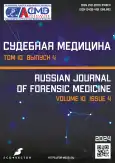The role of alcohol intoxication in fatal road traffic accidents in Moscow
- Authors: Chizhikova I.O.1, Shigeev S.V.1
-
Affiliations:
- Bureau of Forensic Medical Expertise
- Issue: Vol 10, No 4 (2024)
- Pages: 486-497
- Section: Original study articles
- URL: https://journal-vniispk.ru/2411-8729/article/view/288318
- DOI: https://doi.org/10.17816/fm16160
- ID: 288318
Cite item
Full Text
Abstract
Background: The World Health Organization states that approximately 1.19 million people worldwide die annually as a result of road traffic accidents. Driving under the alcohol influence significantly increases the risk of traffic accidents and associated fatalities, which may be attributed to the severity of injuries sustained or the masked progression of traumatic disease during acute alcohol intoxication.
Aim: To evaluate the impact of acute alcohol intoxication on the severity of injuries sustained in road traffic accidents in Moscow and their outcomes based on forensic medical data.
Materials and methods: The study included two stages. At the first stage, data on all fatalities resulting from road traffic accidents in Moscow in 2023 (329 cases) were analyzed. At the second stage, cases with available ethanol testing results (247 cases) were studied. The study objects were forensic medical examination and autopsy reports. Demographic profiles of the deceased, involvement in traffic, time of death, injury patterns, and blood ethanol levels were analyzed. For the first time in Russian practice, injury severity was evaluated using the Forensic Injury Severity Score Template (FISST) scale (an objective and quantitative injury severity assessment system based on autopsy findings).
Results: In 2023, over half of the fatalities from road traffic accidents in Moscow occurred at the time of receiving medical assistance. Most victims were men (239/329; 72.6%; mean age 43.9 years [41.8–46]). Ethanol was detected in 32.4% of cases (80/247) among the victims tested for ethanol (247/329; 75%). Pedestrians and drivers were the most frequent victims of alcohol-related fatalities. The most severe injuries were observed in victims with blood ethanol levels exceeding 3‰; however, no direct correlation between injury severity and blood ethanol level was established in this study. The most severe injuries were found in victims who died during the pre-hospital phase, with chest injuries being the primary contributors to the severity of their condition. Victims who died during the pre-hospital phase also had the highest mean blood ethanol levels.
Conclusion: Ethanol was detected in one-third of road traffic accident fatalities in Moscow. One-quarter of drivers and pedestrians in Moscow died with blood ethanol levels above 0.3‰. All intoxicated drivers died within the first 24 hours following the accident. The most severe injuries were observed in individuals with blood ethanol levels exceeding 3‰. However, the frequency of ethanol detection and blood ethanol levels did not directly influence injury severity or hospitalization duration in this study.
Full Text
##article.viewOnOriginalSite##About the authors
Inna O. Chizhikova
Bureau of Forensic Medical Expertise
Author for correspondence.
Email: chizhikovaio@zdrav.mos.ru
ORCID iD: 0000-0001-6520-9540
SPIN-code: 5582-1090
Russian Federation, Moscow
Sergey V. Shigeev
Bureau of Forensic Medical Expertise
Email: shigeev@mail.ru
ORCID iD: 0000-0003-2219-5315
SPIN-code: 3116-2928
MD, Dr. Sci. (Medicine), Professor
Russian Federation, MoscowReferences
- Cheremisina NV, Cheremisina TN, Grishko YS. Road accidents in russia: Economic and statistical analysis. Vestnik Severo-Kavkazskogo federal'nogo universiteta. 2020;(3):113–121. EDN: YRLNIM doi: 10.37493/2307-907X.2020.3.13
- Chepurny OV. Criminal liability of persons who have committed a road traffic offence while intoxicated. Humanities Social-Econom Social Sci. 2018;(8):119–124. (In Russ). EDN: YABDJZ doi: 10.23672/SAE.2018.2018.16760
- Fattaxov TA. Sources of information about road traffic accidents and recording road traffic injuries in Russia. Demograficheskoe obozrenie. 2014;3(3):127–143. EDN: TLMUZH
- Lastovetskiy AG, Ayvazyan AG, Averyanova DA. Multifactor analysis of mortality on the example of road traffic accidents. Russ J Forensic Med. 2018;(3):10–16. EDN: SQOQTV doi: 10.19048/2411-8729-2018-4-3-10-16
- Kim DG, Choi HS, Lee TH, et al. Postmortem injury evaluation using the Forensic Injury Severity Score Template (FISST): A preliminary study. Forensic Science, Medicine and Pathology. 2023;19(4):484–498. doi: 10.1007/s12024-023-00583-9
- Seliverstov PA, Shapkin YG. Assessment of severity and prognosis of polytrauma outcome: The current state of the problem (review). Modern Tech Med = Sovremennye tehnologii v medicine. 2017;8(2):207. EDN: ZDNDMD doi: 10.17691/stm2017.9.2.25
- Maksimov AV, Kuchuk SA. Characteristics of fatal road traffic injuries in the Moscow region. Russ J Forensic Med. 2020;6(3):36–40. EDN: XPVCSF doi: 10.19048/fm322
- Alvarez-Freire I, López-Guarnido O, Cabarcos-Fernández P, et al. Statistical analysis of toxicological data of victims of traffic accidents in Galicia (Spain). Prevention science. 2023;24(4):765–773. EDN: WBEJCJ doi: 10.1007/s11121-023-01502-8
- Papalimperi AH, Athanaselis SA, Mina AD, et al. Incidence of fatalities of road traffic accidents associated with alcohol consumption and the use of psychoactive drugs: A 7-year survey (2011–2017). Experimental and Therapeutic Medicine. 2019;18(3):2299–2306. doi: 10.3892/etm.2019.7787
- Koval KJ, Cooley M, Cantu RV, Spratt KF. The effects of alcohol on in-hospital mortality in drivers admitted after motor vehicle accidents. Bull NYU Hosp Jt Dis. 2008;66(1):27–34.
- Gonçalves AC, Bombana HS, Canonica AC, et al. Correlation between the severity and blood alcohol level of traffic accidents victims. Acta ortopedica brasileira. 2024;32(spe1):e271878. EDN: OVOVRB doi: 10.1590/1413-785220243201e271878
- Stübig T, Petri M, Zeckey C, et al. Alcohol intoxication in road traffic accidents leads to higher impact speed difference, higher ISS and MAIS, and higher preclinical mortality. Alcohol. 2012;46(7):681–686. doi: 10.1016/j.alcohol.2012.07.002
- Phillips DP, Brewer KM. The relationship between serious injury and blood alcohol concentration (BAC) in fatal motor vehicle accidents: BAC=0.01% is associated with significantly more dangerous accidents than BAC=0.00%. Addiction. 2011;106(9):1614–1622. doi: 10.1111/j.1360-0443.2011.03472.x
Supplementary files











